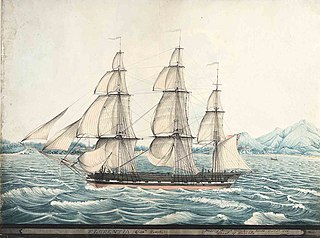Dunvegan Castle was a merchant ship built at Chittagong in 1819. She made two voyages transporting convicts from England and Ireland to Australia. She also transported troops at least twice, once to Burma (1824) and once to Spain (1835). She was lost in 1837.
Camden was a merchant ship built upon the River Thames in 1799 as a West Indiaman. Between 1832 and 1833 she made two voyages transporting convicts from England to Australia. She was wrecked in 1836.
Neptune was a merchant ship built at Whitby, England in 1810. She made two voyages transporting convicts from England to Australia before she was broken up in 1821.
Norfolk was built at Littlehampton, England in 1814. She was originally a West Indiaman, and then sailed to India and Quebec. She made four voyages transporting convicts from England to Australia, one voyage from Ireland to Australia and one from Madras and Mauritius to Australia. She was wrecked on 7 July 1837.

Waterloo was a merchant ship built at Bristol, England in 1815. On her first voyage she suffered a short-lived mutiny. She then made one voyage under charter to the British East India Company (EIC). She made four voyages transporting convicts from England to Australia, and two voyages from Ireland to Australia. On her seventh convict voyage Waterloo wrecked on 28 August 1842 in Table Bay with great loss of life.
Royal Sovereign was a 336-ton merchant ship built at Whitby, England in 1829. She made one voyage transporting convicts from England to Australia and one voyage from Ireland to Australia.
Royal Admiral was a 414-ton timber three-masted barque, built at King's Lynn, England in 1828 and used as a merchant ship. Royal Admiral first served for trade to India. She subsequently sailed to Australia on four occasions carrying convicts, from Portsmouth to Port Jackson in 1830, from Dublin to Port Jackson in 1833 and 1834, and from Woolwich to Hobart Town in 1842.
Recovery was a merchant ship built at Batavia in 1799 and taken in prize c.1811. She made two voyages transporting convicts from England to Australia and one voyage from Ireland to Australia. She also made two voyages for the British East India Company (EIC). She was last listed in 1847.

Florentia was a 453-ton merchant ship built at Newcastle upon Tyne, England in 1821. She made one voyage transporting convicts from England to Australia and one voyage from Ireland to Australia. She made three voyages for the British East India Company (EIC).
Clyde was a merchant ship built at Greenock, Scotland in 1820. She made two voyages for the British East India Company (EIC). She then made three voyages transporting convicts from England and Ireland to Australia. She was last listed in 1845.
City of Edinburgh was a merchant ship built at Bengal in 1813. She transferred to British registry and sailed between Britain and India. She made two voyages transporting convicts from Ireland to Australia. Later, she made a whaling voyage to New Zealand. She was wrecked in 1840.
Captain Cook was a merchant ship built at Whitby, England in 1826. She made one voyage to Bombay under a license from the British East India Company (EIC) in 1828. She then made three voyages transporting convicts from Ireland and England to Australia. In August 1843 she was wrecked on her way with a cargo of coal from Shields to Aden.
Earl St. Vincent was a merchant ship built at Topsham, England in 1800. Between 1818 and 1823 she made three voyages transporting convicts from England and Ireland to Australia.
Eliza was a merchant ship built in Java, Netherlands East Indies, in 1815. She was registered at Calcutta in 1818. She made two voyages transporting convicts from England to Australia. She was last listed in Lloyd's Register in 1848.
England was built at Chepstow, Wales in 1813. She made three voyages transporting convicts from England to Australia. On the first she was under charter to the British East India Company (EIC) and, after delivering her convicts, sailed to Canton where she picked up a cargo for the EIC. She foundered in 1843 in the Channel while on a voyage to Sierra Leone.
Elizabeth was a merchant ship built at Chepstow, Wales in 1809. She made three voyages transporting convicts from England and Ireland to Australia. Elizabeth is no longer listed after 1832 and may have been lost in 1831.
Eliza was a merchant ship built in British India, probably in 1804. Between 1819 and 1831 she made five voyages transporting convicts from England and Ireland to Australia. In between, she also made one voyage for the British East India Company (EIC). Her crew abandoned her at sea in 1836 as she was leaking uncontrollably.

Isabella was a merchant ship built on the Thames, England, and launched in 1818. She made six voyages transporting convicts from England and Ireland to Australia. In between, she made one round trip to China for the British East India Company (EIC). From her launch to 1834 she traded with India and the Far East under a license from the EIC. From 1848 on served in the North America trade. She is last listed in 1850.
Hooghly was a full-rigged merchant ship built on the Thames, England, and launched in 1819. She made two voyages under charter to the British East India Company (EIC), four voyages transporting convicts from England and Ireland to Australia, as well as voyages transporting emigrants to South Australia between 1839 and 1856. Around 1858 she was re-rigged as a barque. She sank off Algiers in 1863.
York was a sailing ship built in 1819 at Southwick. She made one voyage to Bombay for the British East India Company (EIC) in 1820. She made three voyages transporting convicts to Australia between 1829 and 1832. She was condemned and sold for breaking up in 1833 at Mauritius.


